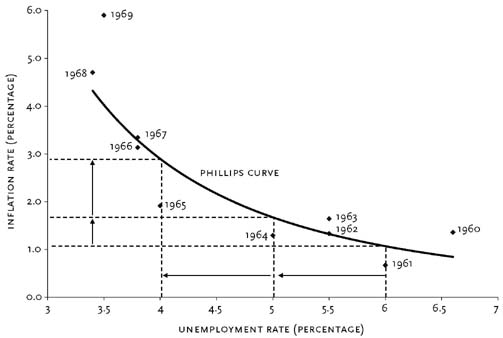Introduction
In the realm of decision-making, mental models play a crucial role in shaping our perceptions and guiding our choices. One such influential mental model is the Phillips Curve. Coined by economist A.W. Phillips in the 1950s, the Phillips Curve suggests an inverse relationship between unemployment and inflation rates. Understanding this mental model is essential, as it can profoundly impact our personal lives, business decisions, and public policy-making processes.
The Phillips Curve: A Definition and Relevance
The Phillips Curve is a concept that posits a trade-off between inflation and unemployment rates. According to the original Phillips Curve theory, when unemployment is high, inflation tends to be low, and vice versa. This relationship was believed to be stable, with policymakers facing a choice between controlling inflation or promoting employment.
The significance of the Phillips Curve lies in its influence on decision-making processes. Governments often grapple with the dilemma of choosing between policies that prioritize low inflation rates or low unemployment rates. This mental model suggests that they cannot achieve both simultaneously, as any actions to reduce one factor could lead to an increase in the other. Understanding the dynamics of the Phillips Curve enables individuals and policymakers to make informed choices while recognizing the inherent trade-offs involved.
Anchored in Human Psychology: The Illusion of Control
The Phillips Curve finds its roots in human psychology, specifically the illusion of control. This cognitive bias leads individuals to believe they have more control over events or outcomes than they actually do. When applied to decision-making, people tend to overestimate their ability to manipulate the economy by adjusting inflation or employment rates. This bias can lead to irrational decisions based on flawed assumptions, ultimately causing unintended consequences.
Examples of the Phillips Curve in Various Contexts
- Personal Life Decisions: Imagine an individual who has been unemployed for an extended period. Faced with financial pressure and anxiety, they may decide to take on a low-paying job just to secure some income. In doing so, they prioritize employment (reducing unemployment) over negotiating for a higher salary (potentially controlling inflation). By succumbing to the Phillips Curve mental model, they inadvertently accept lower wages and perpetuate a cycle of low-income opportunities.
- Business Scenarios: In the business world, companies often face the challenge of balancing cost control and growth. The Phillips Curve mental model can influence strategic decisions related to hiring and compensation. When business leaders believe that higher wages will lead to lower unemployment, they might be inclined to limit salary increases to keep costs down. However, this perspective neglects the potential benefits of investing in human capital and employee satisfaction, which can drive productivity and innovation.
- Public Policy-Making: Governments often face the daunting task of crafting policies to promote economic stability. The Phillips Curve can influence policymakers to prioritize either inflation control or employment generation. For instance, a government focused on reducing inflation might implement strict monetary policies, such as raising interest rates. While this might curb inflation, it can also lead to higher unemployment rates, jeopardizing the overall well-being of the population.
Mental Biases and Psychological Underpinnings
The Phillips Curve mental model is influenced by several cognitive biases and psychological underpinnings. Apart from the illusion of control, individuals may fall victim to confirmation bias, seeking information that confirms their preconceived notions about the relationship between unemployment and inflation. Anchoring bias, which relies heavily on past experiences and information, can also contribute to reinforcing the Phillips Curve fallacy.
Additionally, the availability heuristic can skew decision-making. When individuals are exposed to vivid examples or anecdotes of the Phillips Curve in action, they may mistakenly perceive it as a universal truth. This bias disregards the complexities of economic systems and the multitude of factors that influence unemployment and inflation rates.
Identifying and Avoiding the Phillips Curve Fallacy
To avoid succumbing to the Phillips Curve fallacy, individuals can employ several strategies:
- Diversify Information Sources: Seek a broad range of perspectives and data when evaluating economic relationships. Relying solely on historical patterns may lead to biased conclusions. Stay open to alternative views that challenge conventional wisdom.
- Embrace Complexity: Acknowledge the intricate interplay of numerous factors in economic systems. Understand that oversimplifying the relationship between unemployment and inflation may hinder the ability to make accurate predictions or formulate effective policies.
- Analyze Long-Term Trends: Look beyond short-term fluctuations and consider the long-term consequences of policy decisions. Economic relationships are multifaceted and subject to dynamic shifts. Analyzing historical trends can provide a more comprehensive understanding.
- Adopt Systems Thinking: Recognize that economic phenomena are part of larger interconnected systems. Consider how policies and decisions may have ripple effects across various sectors and stakeholders. Avoid making isolated choices that neglect broader implications.
Conclusion
The Phillips Curve mental model has left an indelible mark on decision-making processes. By understanding its limitations and biases, individuals and policymakers can make more informed choices. By acknowledging the complexities of economic systems and the psychological biases that influence our thinking, we can avoid falling into the trap of oversimplified trade-offs. Cultivating awareness of mental models and actively seeking diverse perspectives enables us to navigate the intricate landscape of decision-making with greater clarity and objectivity.
